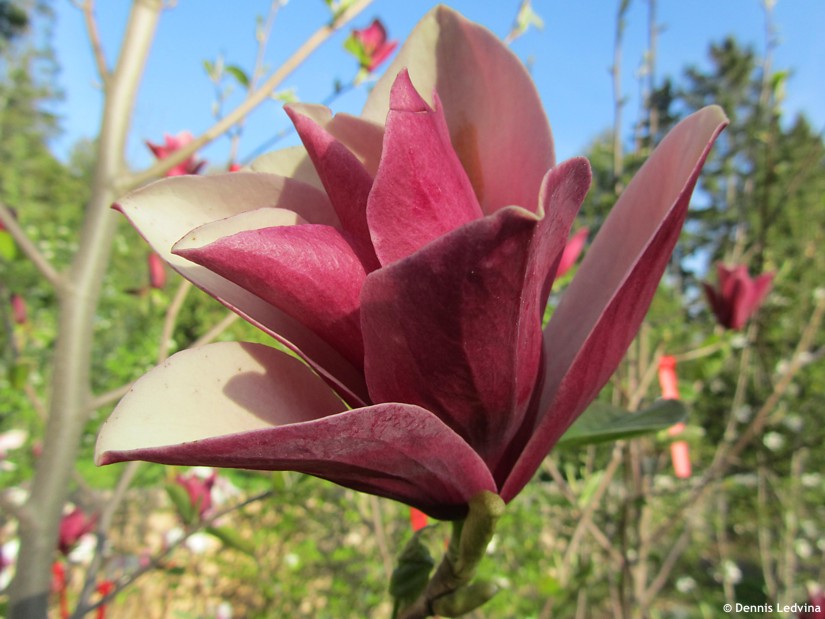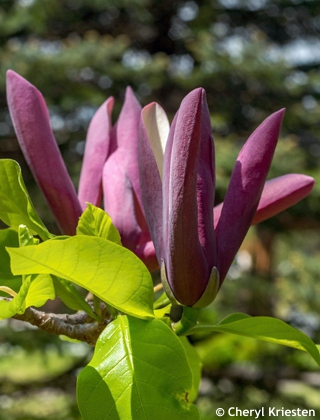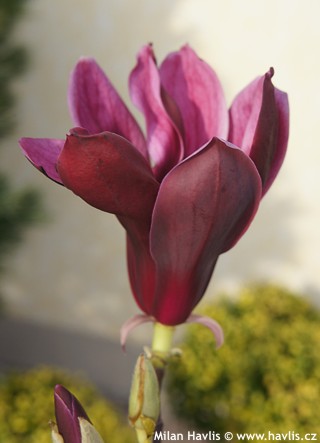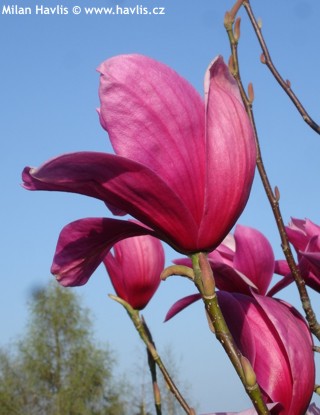Magnolia 'BURGUNDY SPIRE' magnolia
size/type
taller shrub,taller shrub
usual height
4-6m
usual width
1,5-2m
leaves
deciduous broadleaf
colour of leaves
flowers
showy
colour of flowers
blooming time
May-May
location
full to partial sun
soil type
acidic (peaty)
soil moisture requirements
evenly moist (dislikes drought)
USDA zone (lowest)
5 (down to -29°C)
winter protection
for zone 5+6

for zone 7

categorized
Description of the plant:
Burgundy Spire is another beauty among deep red magnólií hybrids. This one was bred by Dennis Ledvina from the USA. Its flowers are velvety deep purple red on the outside, and almost white inside. It is a cross between Yellow Bird (slender growth, yellow flowers) and Apollo (rich pink flowers). Burgundy Spire magnolia received narrowly columnar habit from the first parent, and purple red colour and flower shape from the other one. Flowering begins late in the season, usually in May when there is no or very limited risk of late frosts. Moreover, thanks to the first parent, it produces flower buds also below the main bud and along the lateral branches, offering more than one flush of flowers that keep on blooming for several weeks. The flowers are firm and do not become floppy with age. Leaves are deciduous, rather large, widely obovate, mid green, with no significant autumn colour. Adult trees are expected to reach up to 6m tall but it will take time, perhaps two generations in Central European climate.
Magnolias are not supposed to be pruned. You can prune old shrubs if ill, or trim them to shape or to reduce size, or make an elementary cut to young plants of unsightly or unhealthy appearance. Do this as soon as possible after flowering to secure setting of flower buds for the following year. Be aware that each magnolia can respond differently to pruning.
Deciduous magnolias are quite easy plants. All they need is light, well-drained, acidic soil with equal moisture throughout the year. Once established they can do with occasional drought but will not look as nice as the ones with regular watering. Just pay attention to how to plant your magnolia. First, find it a spot where it will live forever and ever. It does not like transplanting. As it makes shallow roots reaching well over its spread stay away from disturbing the roots by digging or messing about around it. Just cover the soil with bark mulch and do not plant anything else near it after say the second year after planting onwards. You could damage the very important top roots that absorb maximum moisture and nutrients from the soil. Also avoid planting magnolia too deep. Thus you could be digging its grave. The mother plant of this variety was cultivated in Green Bay, Wisconsin which is USDA zone 5 so this magnolia is fine down to at least -29°C. It may survive stronger frost but it has not been tested yet.
Last update 03-02-2016
QUICK PRICE OVERVIEW
CURRENTLY SOLD OUT
WANT TO TRY A SIMILAR PLANT?

















